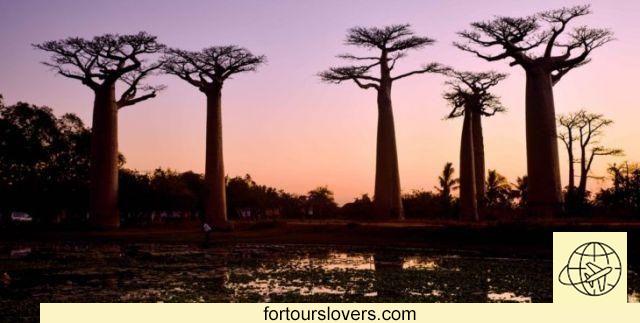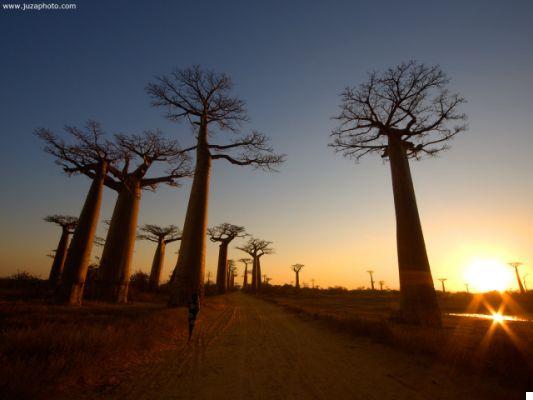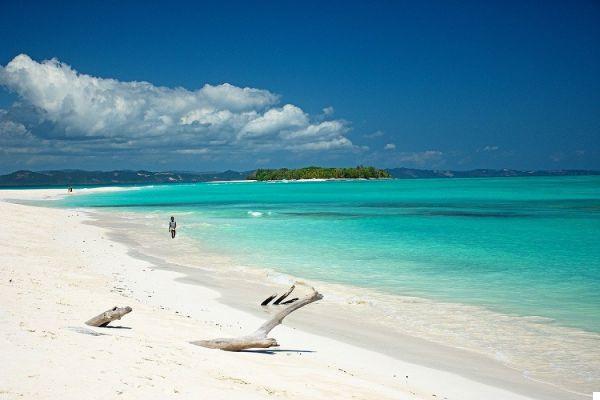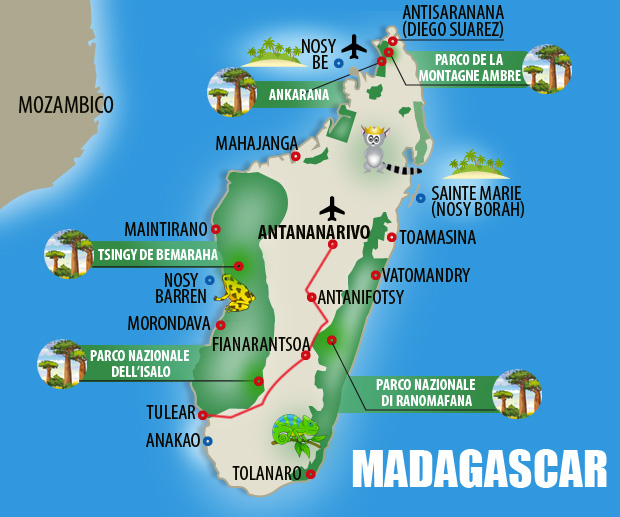
Madagascar
9 things to do and see in Madagascar and 4 not to doDespite political instability, dull institutions, lack of energy and poor infrastructure, Madagascar is a territory with excellent growth opportunities. The great availability of raw material, together with the soil fertility and to one extraordinary biodiversity represent the concrete hope for a better future. Hope that the people firmly believe in, showing optimism e courtesy not facade. And it is precisely the hospitality of the inhabitants one of the aspects that surprises most tourists who choose Madagascar for their holidays. Perhaps the circumstance is due to the fact that the frugality of the Malagasy ties well with the “typical tourist” of the territory. The "Isola Rossa", in fact, is a "mecca" of ecological tourism and therefore frequented mostly by people who like to hike, visit parks, deepen local customs and traditions without imposing their own lifestyle, rather trying to adapt to that of the host country. In short, if you love backpacking, do it diving, snorkeling and enjoy breathtaking views, Madagascar is undoubtedly the right place for you. Below we see together the main attractions of this island, fourth in the world by extension after Greenland, New Guinea and Borneo. Eye: before leaving for a distant destination like Madagascar, it is always advisable to consult the place "Traveling safe" del Ministry of Foreign Affairs, as well as register in the place "Where we are in the world" always within theCrisis Unit of the Farnesina. Happy reading.
1 Nosy Be
Our story begins with most famous tourist resort in Madagascar: the island of Nosy Be. Second by extension to the mother island (Madagascar) from which it is a few nautical miles, Nosy Be owes its fortunes to the mild climate, beaches and beautiful rain vegetation. Nonetheless, the prices for a stay have remained quite low, at least when compared to European ones. Obviously there is no shortage of luxury resorts, or in any case of higher standards, but on the whole you can find good solutions, especially in the capital. Hell Ville. In the south there is Ambatoloaka, one of the busiest beaches on the island. An undoubtedly beautiful place, but accompanied by the very sad fame of sex tourism. A reputation that over the years has negatively affected the locality and against which both the police forces and many accommodation facilities have begun to take opposing positions. The western coast, on the other hand, is decidedly more exotic. More and more beautiful beaches, and more and more deserted, are the ideal destination for a holiday dedicated to the sea and relaxation. Relaxation which, as mentioned at the beginning, finds correspondence in the lifestyle of the inhabitants who, with the expression "Mora mora" (trad. "slowly"), summarize the meaning of their existence on this island. Slow rhythms, therefore, which do not however exclude the possibility of diving, snorkeling and sport fishing on wonderful beaches such as Andilana e Ambondrona. Or, go on excursions to the surrounding islands, such as Nosy Iranja, Nosy Mitsio e Nosy Komba. Finally, the Integral Natural Reserve of Lokobe is worth seeing. Among the most famous land parks in Madagascar, Lokobe boasts an extraordinary biodiversity. Very rich flora and fauna, with the survival of some endemic species such as the Canonga odorous (scientific name: "ylang ylang") from which an essence widely used in perfumery and the macaque lemur (“Eulemur macaco”) widespread in the north-western side of Madagascar.
2 Antsiranana (Diego Suarez)
Antsiranana is the ideal home base for visiting the northern coast of Madagascar. The city, also known with the topos of Diego Suarez (from the name of the Portuguese explorer who first lapped its coasts in 1543), it has a huge bay, second only to that of Rio de Janeiro by extension. Inevitably, the circumstance has favored the development of the port area which has always determined a large part of the gross domestic product of the entire region essentially linked to exports. The other part of the local economy, on the other hand, revolves around tourism. Not so much that of the city, although there is no lack of initiatives in this sense, as that of the surrounding towns. Starting with Shoulders, about 20 km north-east of Diego Suarez, passing through the Three Bays (Sakalava, des Pigeons, des Dunes) up to Sea of Emeraude. These are wonderful inlets, where you can practice water sports and / or simply relax. Getting to each of these locations from Antsiranana is not difficult. In many cases the routes are signposted and represent pleasant excursions even if the time of the year (from April to the windiest November; from December to March in scorching heat) and on-site organization of the trip count a lot. In this regard, it is better to always rely on local guides to avoid unforeseen events along the way (possibility of thefts and robberies). It's not over, because they are absolutely worth a visit too Montagne D'Ambre National Park and Ankarana Special Reserve. These are unique habitats, ideal for Hiking e birdwatching.
3 Marojejy National Park
After Antsiranana, our story continues eastwards towards the Parc National de Marojejy. Among the parks and natural reserves of Madagascar, Marojejy is among the least known, yet, in terms of beauty and biodiversity, it has nothing to envy to the others. The area, halfway between the cities of Andapa e Sambava, was visited in depth for the first time in 1948 since French botanist Jean Henri Humbert, protagonist of multiple expeditions to Madagascar and Southern Africa. In 1952, also on the basis of the studies carried out by Humbert, described in the Natural History Museum in Paris, Marojejy was declared a Nature Reserve. This remained the status of the area until 1998 when it was instead declared a Natural Park and, in this way, made accessible to all. The last recognition in 2007 by theUNESCO international convention against doping in the sport which has included this and other parks in Madagascar among the sites World Heritage Site. Among the reasons behind the protection is the extraordinary biodiversity of the area: 4 different types of rainforest; 35 species of palm trees; 75 bird species; 149 species of amphibians and reptiles and 11 species of lemurs, including the very rare Silky Sifaka (o White sifaka, scientific name Propithecus candidus, see photo). Visiting the Marojejy National Park is not difficult. On the park card (click here) you will find all the information on microclimates; seasons; excursions; the habitats and dangers that threaten this wonderful naturalistic area. The objectives pursued are many: on the one hand, the environmental education of the populations who live close to the area to avoid, for example, very harmful practices such as the smuggling of rosewood (wood in great demand in the West); on the other hand, however, the promotion of ecotourism as a form of active protection of the area. In short, as we said at the beginning, Madagascar is a backpacking trip. You will not regret it!
4 Antananarivo
After Marojejy it is the turn of Antananarivo, the capital of Madagascar. We have included it as a fourth point because it is one chaotic and difficult to visit metropolis. However, in many cases, it represents the starting point for exploring the island, being at the same time the first airport and the most important road junction. To see, the Royal Palace (Rova), which rises in the upper part of the city (Upper Town) where most of the tourist attractions are concentrated. It is a fortress that, although quite remodeled, offers an interesting insight into the Malagasy history, or rather, of the centuries-old domination Merina tribe on the city and on the island. This ethnic group, from which the most recent heads of state of Madagascar also come, is still the most numerous in the area even if, it must be said, Antananarivo is a compendium of all Malagasy ethnic groups, to which we must add the French presence, a legacy of history colonial of the island. Moreover, it was the French who designed the city by providing, in addition to the upper part, also a lower part (Basse Ville) characterized by markets of all kinds, car traffic and several hotels excellent as a base for arriving and departing travelers. In addition to the Rova, the Andafivaratra Museum, with numerous relics of the Merina dynasty, and the Lake Anosy, easily accessible from Haute Ville. In the surroundings, however, we point out the Lemur's Park (www. lemurspark.com) about 20 km from the capital. If you haven't seen them yet or, on the contrary, you are not tired of seeing them, this private park is home to several specimens of lemurs, which are allowed to move freely within the area.
5 Ambohimanga
La Ambohimanga Royal Hill it is located about 20 kilometers north of Antananarivo so those who are based in the capital of Madagascar can easily visit the town within a day. The site has considerable importance both under the historical-religious profile and from an architectural point of view. Historically, the "Blue Hill" (the other name by which Ambohimanga is known) represents the symbol of the political power of the Merina, architects of the unification of Madagascar. As far as religion is concerned, however, it must be borne in mind that the rulers of the dynasty were buried there. The royals were honored with a series of ritual donations, the study of which reveals two elements of great anthropological interest: on the one hand, the devotion to ancestors, culturally attributable to the Indonesian stock (from which the Merina themselves come); on the other, the reverence for royal power, which is instead a cultural trait typical of African culture. This double communicative register can also be found in the choice of materials used in construction. For example, the fortress of King Andrianampoinimerina (Rova) is mainly built in wood (living material) and according to indigenous construction techniques, while the tombs, as well as the entrance gates all around the hill, are in stone (cold and inert material). It is also interesting to observe the residence of Queen Ranavalona I, not far from the royal palace (see photo). On the traditional layout, in fact, there are evident stylistic overlaps extraneous to Malagasy architecture. The reason is that the design of the house was provided by a French engineer, Jean Laborde, at the queen's court. In short, Ambohimanga is a spiritual place, still a stage of pilgrimages by the local population, from whose visit, however, various ideas are obtained to deepen the genius loci of the island. It is not over, because the locality is also important from a naturalistic point of view. In fact, the forest that surrounds the archaeological site hosts several endemic species, including the rare Phyllarthron madagascariense, plant for domestic and medicinal use. For all the reasons explained so far Ambohimanga, since 2008, is under UNESCO protection. To be seen!
6 Isalo National Park
Il Parc National de l'Isalo it is undoubtedly the most important place in southern Madagascar. The kilometers from the capital Antananarivo are about 700, while the gateway to the area is represented by Ranohira, a village at 1000 meters above sea level inhabited mainly by one nomadic tribe of African origin, i Bar. Isalo is a park famous above all for its canyon, rocky reliefs modeled by the atmospheric agents at the bottom of which they flow streams ending in beautiful natural pools. A desert setting, therefore, which attracts thousands of tourists from all over the world also for its similarity with the landscapes of Colorado and Arizona. Clearly choosing locations like these are above all passionate about trekking ed off-road excursions, even if the great popularity of the area has favored over time the opening of more affordable itineraries, suitable for those who want to experience one wild holiday but without exaggerating. The main points of interest inside the park are the Window of the Isalo (Fenetre de l'Isalo) Queen of Isalo (Reina de l'Isalo) and Natural Pool (Piscine Naturelle). The first is a rock sculpture whose shape recalls that of a window. In some hours of the day, especially at sunset, this window frames wonderful landscapes which, thanks to the particular light conditions, take on different colors ranging from golden to reddish. The Queen of Isalo is another natural sculpture that would instead recall the features of a woman, while the Natural Pool is located at the end of one of the most traveled paths in the park. An excursion which, although short (3 km. Approx.), Has some uphill sections that require a minimum of physical preparation. The effort, however, is amply rewarded by the possibility of taking a bath in a natural setting of incomparable beauty. It goes without saying that the Parc National de l'Isalo offers the possibility of much longer and more demanding hikes. Never alone, of course, but with the help of expert local guides, which is why please refer to the park card for all the details of the case.
7 Anakao
As if the parks and nature reserves were not enough all over the island, Madagascar boasts one of the coral reefs largest in the world. More precisely, 450 kilometers of coral reefs that cut the west coast from north to south: from Morombé to Tuléar (Toliara). The latter is a town of over 100.000 inhabitants with an airport, a must for those who have as a priority to visit the Isalo National Park and / or the village of Anakao. Touristically, Anakao is the alternative to the island of Nosy Be. If you want an exotic beach holiday then it is undoubtedly the right choice. In fact, despite the tourist expansion of recent years (there are some of the most luxurious resorts in Madagascar), the locality is still almost intact. Almost desert beaches, mostly frequented by nomadic fishermen of the Vezo ethnic group, very recognizable due to the pirogues used for fishing trips. In Anakao, therefore, you can relax on the beach and practice various water sports: diving, kitesurfing, snorkeling up to whale-watching, very popular from June to September. In fact, it is in these months that the whales cross the Mozambique channel and can be observed closely on board the local fishermen's boats. Obviously, those who want can also dedicate themselves to trekking. From Anakao you can reach the Tsimanampetsotse National Park which offers several interesting naturalistic ideas. Finally, Anakao can also be the last stage of the RN7 (Route National 7) the state road connecting the capital Antananarivo to Toliara (900 km). From Toliara, then, we continue towards Anakao. To do.
8 Tsingy de Bemaraha National Park
Il Parc de Tsingy de Bemaraha represents a unicum in the rich panorama of natural reserves and national parks of Madagascar. It is a huge one stone forest, still not fully explored, which, for his mysterious charm, attracts hikers from all over the world. Obviously, since it is a complex habitat, a visit to the park is not suitable for everyone. In fact, a minimum of physical preparation and, even more, the determination necessary to endure a preliminary 7 hours of off-road vehicle from the city of Morondava plus another 2, 3 hours to cross the two rivers that lead into the park on board a pirogue. There are hundreds of kilometers of limestone pinnacles called precisely "Tsingy" from the Malagasy. These natural spiers they have designed real labyrinths in the midst of which, however, live reptiles, amphibians, birds and various species of lemurs. Here and there there is also space for vegetation with some plants of great scientific interest for their ability to adapt to such unique environmental conditions. Since the UNESCO protection arrived, the park has significantly improved from an infrastructural point of view: metal steps, climbs, bridges and mountaineering itineraries are available for those wishing to try their hand at one of the many circuits present. The area is divided into two major areas: Petit Tsingy and Grands Tsingy. The first is the relatively more accessible one with several itineraries ranging from one hour walk to six hour hikes. The second, as the name suggests, is more suitable for professional hikers who have one of the largest expanses of limestone pinnacles in the world in front of them. For more information see the place: www.parcs-madagascar.com.
9 Avenue of the Baobabs
Going or returning from the Parc National des Tsingy de Bermaraha one cannot fail to stop to admire the avenue of the Baobabs (Allée des Baobabs). It is a short section of the RN8 (the road that connects Morondava a Belo Sur Tsiribihina) flanked by imposing specimens of "Adansonia grandidieri", one of several endemic baobab species of Madagascar. Trees up to 30 meters high, with imposing trunks and bushy branches at the center of various legends with a religious background. The Malagasy, in fact, consider these sacred trees and worship them as gods. Divinities who have been facing an insidious threat for years: the intensive agriculture of rice which - as is well known - needs a lot of water, altering the habitat in which the baobabs grow. The growing tourist popularity, however, has given an economic opportunity to the inhabitants of the area who have begun to sell junk and various tools to the dozens of off-road vehicles that stop along the avenue every day. The best times to visit (and photograph) the Avenue of the Baobabs are at sunrise and sunset. To be seen!
1 Beware of thefts
Madagascar is one of the poorest nations in the world. Unfortunately, the large availability of raw materials and the tourist economy have not led to significant improvements in living conditions. In contexts of great poverty there is never a lack of thefts and robberies. Therefore you must always be careful, especially in the larger cities like Antananarivo, Diego Suarez, Tulear etc. Especially in the evening it is preferable not to go out alone. Better to accompany someone from the place, even if the attention, in itself, is not a guarantee of immunity. In fact, there is no lack of taxi robberies operating at night. For all these reasons it is necessary to plan well the movements from one place to another.
2 Don't violate local traditions
The warning, we realize, is too general but the point is that there are hardly ever precise decalogues to respect (with the significant exception of the nomadic Vezo tribe). Each village has its own taboos that it would be preferable not to violate in order not to harm the ancestors. Even whistling on the beach could be inappropriate even if - it must be said - the tolerance threshold towards foreigners is much higher. However, this does not mean that it is always better to inquire about the customs of each locality.
3 Be careful not to alter the places
Do not buy items made with precious woods; do not drag diving equipment on the coral reef; do not touch live marine organisms; do not detach branches, leaves, plants on your own initiative. It is even superfluous to have to reiterate it, considering that the “typical tourist” of Madagascar already has this kind of sensitivity in their strings, but we willingly run the risk of being pedantic. The future of the “Isola Rossa”, in fact, passes above all from the preservation of its environmental specificities and therefore even small gestures in perspective are of great importance.
4 Watch out for prostitution
Prostitution is a scourge that the government of Madagascar is trying to remedy by increasing penalties and seeking the active involvement of locals and accommodation facilities. Therefore, deliberately going in search of paid sexual services is a behavior, as well as deplorable, very risky from a judicial point of view. Beware also of "too explicit" flattery. It is almost always not a question of advances, but of well-disguised prostitution circles.






